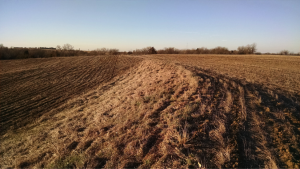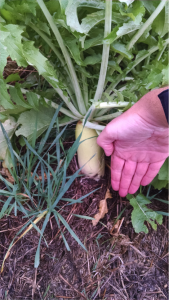
Editor’s Note: This is the second in a series of blog posts highlighting Sustainable Agriculture Research and Education (SARE) projects. Our last SARE: Stories from the field blog featured an Oregon State University project, which used SARE funds to quantify the nitrogen benefits of cover crops.
The Sustainable Agriculture and Research Education (SARE) program is a farmer-driven research, education and extension grant program designed to help advance agricultural innovations that improve profitability, stewardship and quality of life. Over the past 25 years, SARE has helped to produce cutting edge sustainable agriculture research and supported on-farm projects and experiments that allow farmers of all stripes to better address the pressing challenges facing their farming operations.
Josh Roe, a Kansas-based agricultural economist, has recently been working on a project to help local farmers quantify the financial risks of adopting cover crops entitled, “Economics of Grazing and Haying Cover Crops”. The project also provides sample figures for the financial benefits of cover crop rotation models.
Roe’s experience teaching the environmental and economic benefits of different conservation practices at Kansas State University (KSU) (and later with the Kansas Department of Agriculture), combined with his personal experience as a no-till farmer helped him to develop the idea for his first SARE project.
Roe’s family has been farming and ranching 3,000 acres in north central Kansas for six generations. The farm has been no-till for 22 years and is cultivated under a dryland crop rotation of corn, soy and wheat. The farm also produces silage, including alfalfa and sorghum, which supports their cattle operation. Although Roe initially left the farm to pursue higher education, he eventually returned to the area to teach agricultural economics at KSU, and to co-manage the farm with his father and grandfather. Today, Roe serves as the Assistant Secretary of the Kansas Department of Agriculture.
Through his work at KSU and the Kansas Department of Agriculture, Roe was already familiar with the environmental and carbon-mitigation benefits of using cover crops and no-till practices, but as an economist and as a farmer, he saw a need to quantify the economic benefits of cover cropping in his region. In 2014, Roe applied for and was awarded a SARE grant to research the Economics of Grazing and Haying Cover Crops in North Central Kansas. Roe collaborated with Kerri Ebert, the Kansas SARE coordinator and Dr. Peter Tomlinson of KSU Research and Extension to develop the project idea, and for technical agronomic advice on how to implement field trials.
“[SARE] allows producers of all sizes to think outside of the box about agriculture with minimal economic risk,” said Roe. “It empowers producers to think at a higher level by enabling them to collect real data on their projects, and it gets producers out of their comfort zone by sharing their ideas and results not only at a neighbor or community level, but also at a national level through the network of SARE’s regional offices.”
Together with his research team, Roe developed a plan to test three fields: a control field that was seeded with a cover crop and left alone, a

20-acre field planted with hay, and a 61-acre field that was seeded with a cover crop mix and cross-fenced for cattle grazing. The cover crop mix included oats, spring field peas, radish, turnips, and sorghum. Trials began immediately after the fall wheat harvest in October 2014 and concluded the following spring.
Financial and Environmental Benefits of Multiple Cover Crop Models
Roe’s research project found significant financial benefits were to be had through the use of cover crops. Of these field trials, the hayed portion yielded nearly 1.6 tons per acre, which resulted in net earnings of $19.40 per acre.
The cover-cropped field (used for grazing steers) also demonstrated a net profit: the livestock was sold at $1.91 per pound, with a cost of weight gain of $0.68 per pound. This cost of weight gain (which includes the costs of planting a cover crop, supplemental feed, and labor costs) was significantly lower than that of other cattle raised by Roe on his ranch during the same year, indicating a greater profitability when using cover crops to graze livestock during the winter months as compared to leaving the field bare.
While this single-season, single-location trial demonstrated financial success in using cover crops for grazing and silage production, the short trial period did not allow for the quantification of long-term yield benefits on crops following cover crop production. However, the annual SARE Cover Crop Survey, which in the past year has collected data from over 2,400 farmers from across 47 states, has found significant increases in both corn and soy yields following cover cropping.
Roe’s experiment also demonstrated that key environmental, soil health, and retention benefits could be achieved through cover crop use. During spring rains, soil erosion and the development of gullies were evident on an adjacent field that was fallow, while the root structure of the established cover crops on the trial fields helped to anchor the soil, reducing sheet and rill erosion on that field.
Building Farmer Capacity to Assess Individual Cover Crop Practices
Localized research such as Roe’s can help farmers make informed decisions on sustainable crop diversification, as well as help them to develop the tools to make their own assessments. Without a SARE grant, Roe says he would not have undertaken the trial with the same level of detail in data collection and financial risk assessment, and most importantly, without SARE Roe would not have been able to engage in the same level of farmer outreach.

Roe worked directly with farmers in his community through field days, during which he invited over fifty farmers to visit the fields while trials were ongoing. After the project’s completion, KSU and the state extension agency were able to share the results of Roe’s work and distributed pictures of his trials through their network and at statewide presentations, which reach hundreds of farmers.
While no-till practices are common in north central Kansas (adoption rates are estimated to be greater than 50 percent on all agricultural land) cover cropping is less practiced in the region.
After sharing his research findings with other farmers, Roe says, “I continue to get questions from producers and I know people are thinking and talking about cover crops more as a result of this research.”
On their own farm, Roe and his father are now considering introducing a cover crop rotation after harvesting silage toward the end of the summer.
The Future of SARE Research Funding
Increased investment in sustainable agricultural research is vital to continued productivity and innovation in American agriculture. SARE has been at the forefront of research and extension activities that develop profitable, environmentally sound, and resilient farming systems.
Despite SARE’s popularity and productivity, however, it is still not funded at even half of its authorized amount, and was not provided an increase in the recent House appropriations bill. NSAC urges Congress to match the Administration’s budget request to fund SARE at $30 million in Fiscal Year 2017, which would bring the funding to just half of the authorized spending level.

